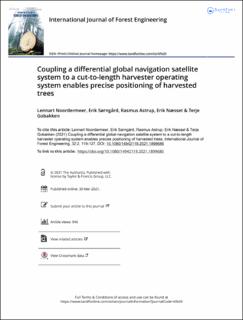| dc.contributor.author | Noordermeer, Lennart | |
| dc.contributor.author | Sørngård, Erik | |
| dc.contributor.author | Astrup, Rasmus | |
| dc.contributor.author | Næsset, Erik | |
| dc.contributor.author | Gobakken, Terje | |
| dc.date.accessioned | 2022-02-21T09:57:10Z | |
| dc.date.available | 2022-02-21T09:57:10Z | |
| dc.date.created | 2022-02-09T14:01:36Z | |
| dc.date.issued | 2021-03-30 | |
| dc.identifier.citation | International Journal of Forest Engineering. 2021, 32 (2), 119-127. | en_US |
| dc.identifier.issn | 1494-2119 | |
| dc.identifier.uri | https://hdl.handle.net/11250/2980423 | |
| dc.description.abstract | Cut-to-length harvesters collect detailed information on the dimensions and characteristics of individual harvested trees. When equipped with global navigation satellite system (GNSS) receivers and motion sensors, the obtained measurements can be linked to locations of single harvested trees, benefitting a range of forest inventory applications. We propose a way of georeferencing harvested trees using a Komatsu 931XC harvester, which measures and records the machine's bearing, crane angle and crane length for each harvested tree. We replaced the harvester’s standard GNSS receiver with a dual-antenna differential GNSS receiver. From the coordinates obtained, rotations calculated from the GNSS receiver and data on crane length, we determined the location of 285 trees harvested in eight final fellings in Norway. We compared the obtained locations to control measurements taken on the corresponding stumps directly after harvest using a differential GNSS receiver. The mean distance between planimetric coordinates of trees measured by the harvester and corresponding control measurements was 0.88 m with a standard deviation of 0.38 m. By correcting the crane lengths for systematic deviations between harvester and control locations, the mean distance was reduced to 0.79 m. This study shows that measurements of single harvested trees can be georeferenced with sub-meter accuracy, by mounting a differential GNSS receiver on a harvester and without installing additional sensors. The results also suggest that the positional accuracy can be further improved by measuring and recording the length of the telescopic boom, and that with minor adjustments, the system could be fully automated. | en_US |
| dc.language.iso | eng | en_US |
| dc.publisher | Taylor & Francis Group LLC | en_US |
| dc.rights | Attribution-NonCommercial-NoDerivatives 4.0 Internasjonal | * |
| dc.rights.uri | http://creativecommons.org/licenses/by-nc-nd/4.0/deed.no | * |
| dc.title | Coupling a differential global navigation satellite system to a cut-to-length harvester operating system enables precise positioning of harvested trees | en_US |
| dc.type | Peer reviewed | en_US |
| dc.type | Journal article | en_US |
| dc.description.version | publishedVersion | en_US |
| dc.rights.holder | © 2021 The Author(s) | en_US |
| dc.source.pagenumber | 119-127 | en_US |
| dc.source.volume | 32 | en_US |
| dc.source.journal | International Journal of Forest Engineering | en_US |
| dc.source.issue | 2 | en_US |
| dc.identifier.doi | 10.1080/14942119.2021.1899686 | |
| dc.identifier.cristin | 1999570 | |
| dc.relation.project | Norges forskningsråd: 281140 | en_US |
| cristin.ispublished | true | |
| cristin.fulltext | original | |
| cristin.qualitycode | 1 | |

